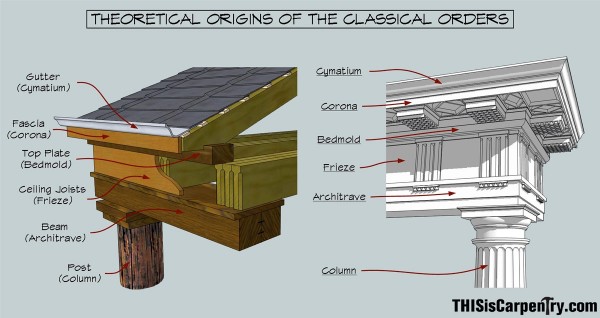The classical orders of architecture—Doric, Ionic, Corinthian (and later Tuscan and Composite)—have both practical and theoretical origins that trace back to ancient Greece and Rome. These orders aren’t just styles; they’re systems based on proportion, function, and cultural meaning. Here’s a breakdown of their theoretical origins:
Mythological and Symbolic Origins
Classical authors, especially Vitruvius, associated each order with symbolic human characteristics:
-
-
-
-
-
Doric: Masculine, strong, and simple. Vitruvius believed it was inspired by the proportions of a man—solid and muscular.
-
Ionic: Feminine and graceful. Modeled after the form of a woman, with volutes (scrolls) representing curls of hair.
-
Corinthian: Virgin maiden. The most ornate, said to be inspired by a basket left on a young girl’s grave, around which acanthus leaves grew.
-
-
-
-
These symbolic interpretations provided narrative justification for their form and use.
Functional and Structural Origins
The orders evolved from wooden post-and-lintel construction:
-
-
-
-
-
Early temples were built in timber. Over time, the structural elements (columns, capitals, entablatures) were translated into stone while preserving their original purpose and visual form.
-
For example, triglyphs in the Doric frieze may represent wooden beam ends, and mutules mimic projecting rafters.
-
-
-
-
Mathematical and Proportional Systems
Greek architects developed codified systems of proportion based on the human body (an idea later echoed by Renaissance architects like Alberti and Palladio). These proportions governed:
-
-
-
-
-
Column height to diameter ratios
-
Spacing between columns
-
Proportions between base, shaft, capital, entablature, and so on
-
-
-
-
Each order had its own ruleset, reflecting both aesthetic ideals and functional logic.
Philosophical and Aesthetic Foundations
In Greek philosophy, especially Platonism and Pythagoreanism, beauty was seen as emerging from harmony, order, and proportion—concepts which heavily influenced classical architecture.
-
-
-
-
-
Architecture wasn’t just about building; it was a reflection of cosmic order.
-
The classical orders were tools to express that harmony in built form.
-
-
-
-
Cultural and Political Expression
Each order also carried associative meaning:
-
-
-
-
-
Doric was used in temples to male gods (like Zeus) and conveyed strength.
-
Ionic was more elegant, used in temples to goddesses (like Artemis).
-
Corinthian, being lavish, became popular in Roman civic buildings, symbolizing wealth and power.
-
-
-
-



